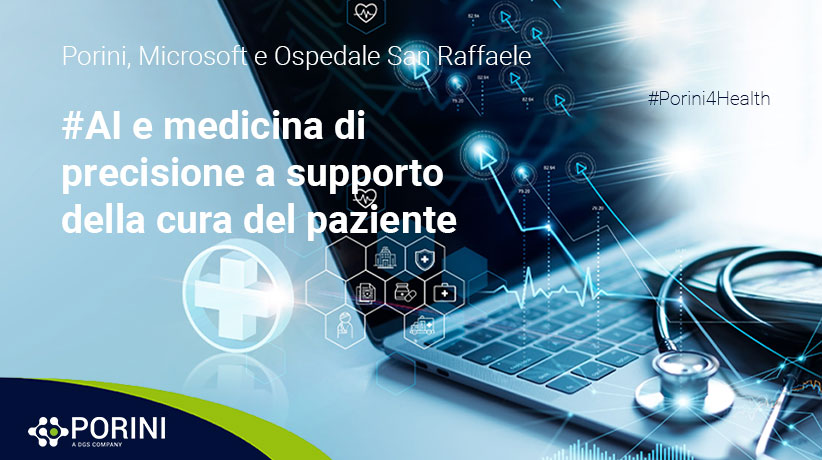![]()
Porini, Microsoft and the San Raffaele University and Research Hospital transform clinical research with a machine learning solution to deliver precision medicine.
“Treating as many patients as possible with state-of-the-art and modern solutions is the fundamental goal of the San Raffaele University and Research Hospital,” says Carlo Tacchetti, Professor of Human Anatomy at the Vita-Salute San Raffaele University.
To support this, the organisation relies on data and artificial intelligence.
San Raffaele has always been committed to researching new therapeutic approaches to tackle diseases such as diabetes, lung cancer and more while improving the patient experience. The use of artificial intelligence and cloud technology, with their enormous potential for analysing data and generating insights, have proved to be two key levers in achieving this important goal.
The arrival of the pandemic in 2020 marks a crucial watershed in this research.
In 2020, San Raffaele receives over 20,000 Covid patients and, like many other hospitals, plunges into a state of emergency.
In order to contain the crisis, it becomes essential to find ways of speeding up the assessment of incoming patients by also understanding how the disease would develop, thus envisaging the type of support needed by the patient from self-isolation at home monitored remotely to admission to intensive care.
“We wanted to be able to predict the type of support the patient would need based on a few objective parameters collected on arrival and we wanted to do this in no more than 30 minutes,” says Dr Anna Flavia d’Amelio Einaudi, CEO of the Vita-Salute San Raffaele University.
“It was the beginning of our partnership with Microsoft and Porini and the birth of our AI project”
Born out of the close collaboration between Porini, the Microsoft Industry Solutions and Cloud for Healthcare teams and the hospital, the platform is designed to help San Raffaele tap into the most up-to-date, industry-specific technologies and expertise that Microsoft has to offer.
Porini and Microsoft immediately realised the benefits of a data-driven approach beyond the pandemic. As part of the programme, the platform developed was able to generate new insights and, when used in production, reduce Covid patient admissions by 27%.
This data convinced the hospital to extend the pilot project beyond the Covid experience by investing in a project that would allow them to derive much more information from the routinely collected data.
The machine learning solution is already proving crucial in improving the end-to-end patient journey within their hospital.
For Antonello Bianchi, Healthcare and Life Science Solutions Lead at Porini, it was also an opportunity to explore a completely new approach to AI. “Everything about this solution is customised and tailored to the needs of the hospital and the research teams that use it,” he says.
“This means building models that specifically meet the needs of clinical research, but also providing insights into the daily activities of doctors, helping them to keep track of their workflows”.
Stefano Brusamolino, Practice Lead Healthcare and Life Science at Porini adds: “Throughout the development phase, we made sure to sit down with the doctors and build it with the data and functionality they provided, following their input and creating something that was flexible, compatible with their needs and easy to use.”
“This was the real secret to the success of our solution.”
![]()
Porini, Microsoft e il San Raffaele University and Research Hospital trasformano la ricerca clinica con una soluzione di machine learning che permette di offrire medicina di precisione.
“Trattare il maggior numero possibile di pazienti con soluzioni all’avanguardia e moderne è l’obiettivo fondamentale dell’’Ospedale Universitario e di Ricerca San Raffaele” afferma Carlo Tacchetti, Professore di Anatomia Umana presso l’Università Vita-Salute San Raffaele.
Per supportare questo, l’organizzazione si affida a dati e intelligenza artificiale.
Il San Raffaele è da sempre impegnato nella ricerca di nuovi approcci terapeutici per affrontare malattie come diabete, il cancro ai polmoni e altro ancora migliorando al tempo stesso l’esperienza del paziente. L’uso dell’intelligenza artificiale e della tecnologia cloud, grazie all’enorme potenziale nell’analisi dei dati e nella generazione di approfondimenti che consentono si sono rivelate due leve fondamentali nel raggiungimento di un importante traguardo.
L’arrivo della pandemia nel 2020 segna uno spartiacque cruciale in questa ricerca.
Nel 2020 il San Raffaele accoglie oltre 20.000 pazienti Covid e, come molti altri ospedali, precipita in uno stato di emergenza.
Per contenere la crisi diventa indispensabile trovare il modo di accelerare la valutazione dei pazienti in arrivo comprendendo anche come si sarebbe sviluppata la malattia, prevedendo così il tipo di supporto necessario al paziente dall’autoisolamento domiciliare monitorato a distanza fino al ricovero in terapia intensiva.
“Volevamo essere in grado di prevedere il tipo di supporto di cui il paziente avrebbe avuto bisogno sulla base di pochi parametri oggettivi raccolti all’arrivo e volevamo farlo in non più di 30 minuti”, afferma la Dott.ssa Anna Flavia d’Amelio Einaudi, Amministratore Delegato dell’Università Vita-Salute San Raffaele.
“È stato l’inizio della nostra partnership con Microsoft e Porini e la nascita del nostro progetto AI”.
Nata dalla stretta collaborazione tra Porini, i team di Microsoft Industry Solutions e Cloud for Healthcare e l’ospedale, la piattaforma è progettata per aiutare il San Raffaele ad attingere alle tecnologie e alle competenze più aggiornate e specifiche del settore che Microsoft ha da offrire.
Porini e Microsoft hanno subito intuito quali potevano essere i vantaggi di un approccio basato sui dati anche oltre la pandemia. Nell’ambito del programma la piattaforma sviluppata permetteva di generare insight nuovi e, se utilizzata in produzione, di ridurre del 27% i ricoveri dei pazienti Covid.
Questi dati hanno convinto l’ospedale a estendere il progetto pilota oltre l’esperienza Covid investendo in un progetto che avrebbe permesso di ricavare molte più informazioni dai dati abitualmente raccolti.
La soluzione di machine learning si sta già dimostrando cruciale nel migliorare il percorso end-to-end del paziente all’interno del loro ospedale.
Per Antonello Bianchi, Healthcare and Life Science Solutions Lead di Porini, è stata anche un’opportunità per esplorare un approccio completamente nuovo all’AI. “Tutto ciò che riguarda questa soluzione è personalizzato e adattato alle esigenze dell’ospedale e dei team di ricerca che la utilizzano”, afferma.
«Ciò significa costruire modelli che rispondano specificamente alle esigenze della ricerca clinica, ma anche fornire approfondimenti sulle attività quotidiane dei medici, aiutandoli a tenere traccia dei loro flussi operativi».
Stefano Brusamolino, Practice Lead Healthcare and Life Science in Porini aggiunge: “Durante l’intera fase di sviluppo, ci siamo assicurati di sederci con i medici e di costruirlo con i dati e le funzionalità che hanno fornito, seguendo i loro input e creando qualcosa che fosse flessibile, compatibile con le loro esigenze e facile da usare.”
“Questo è stato il vero segreto del successo della nostra soluzione.”





